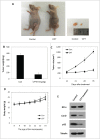Cryptotanshinone inhibits breast cancer cell growth by suppressing estrogen receptor signaling
- PMID: 25482936
- PMCID: PMC4622426
- DOI: 10.4161/15384047.2014.962960
Cryptotanshinone inhibits breast cancer cell growth by suppressing estrogen receptor signaling
Abstract
Estrogen receptor (ER) is a major therapeutic target for the treatment of breast cancer, because of the crucial role of estrogen signaling deregulation in the development and progression of breast cancer. In this study, we report the identification of a novel ERα binding compound, cryptotanshinone (CPT), by screening the CADD database. We also show that CPT effectively inhibits estrogen-induced ER transactivation and gene expression of ER target genes. Furthermore, we showed that CPT suppressed breast cancer cell growth mainly in an ERα dependent manner. Finally, we confirmed the potential therapeutic efficiency of CPT using xenograft experiments in vivo. Taken together, our results describe a novel mechanism for the anticancer activity of CPT and provide supporting evidence for its use as a potential therapeutic agent to treat patients with ERα positive breast cancer.
Keywords: CADD, computer-aided drug design; CPT, cryptotanshinone; ER, estrogen receptor; EREs, estrogen-responsive elements; ROS, reactive oxygen species; SERM, selective estrogen receptor modulator; breast cancer; cryptotanshinone; estradiol; estrogen receptor.
Figures





Similar articles
-
Cryptotanshinone inhibition of mammalian target of rapamycin pathway is dependent on oestrogen receptor alpha in breast cancer.J Cell Mol Med. 2017 Sep;21(9):2129-2139. doi: 10.1111/jcmm.13135. Epub 2017 Mar 8. J Cell Mol Med. 2017. PMID: 28272775 Free PMC article.
-
Benzopyran derivative CDRI-85/287 induces G2-M arrest in estrogen receptor-positive breast cancer cells via modulation of estrogen receptors α- and β-mediated signaling, in parallel to EGFR signaling and suppresses the growth of tumor xenograft.Steroids. 2013 Nov;78(11):1071-86. doi: 10.1016/j.steroids.2013.07.004. Epub 2013 Jul 26. Steroids. 2013. PMID: 23891847
-
Estrogen-related receptor-alpha antagonist inhibits both estrogen receptor-positive and estrogen receptor-negative breast tumor growth in mouse xenografts.Mol Cancer Ther. 2009 Mar;8(3):672-81. doi: 10.1158/1535-7163.MCT-08-1028. Epub 2009 Mar 10. Mol Cancer Ther. 2009. PMID: 19276159
-
Estrogen receptors and their downstream targets in cancer.Arch Histol Cytol. 2004 Dec;67(5):435-42. doi: 10.1679/aohc.67.435. Arch Histol Cytol. 2004. PMID: 15781984 Review.
-
Genome-Wide Estrogen Receptor Activity in Breast Cancer.Endocrinology. 2021 Feb 1;162(2):bqaa224. doi: 10.1210/endocr/bqaa224. Endocrinology. 2021. PMID: 33284960 Free PMC article. Review.
Cited by
-
Chinese Medicines Improve Perimenopausal Symptoms Induced by Surgery, Chemoradiotherapy, or Endocrine Treatment for Breast Cancer.Front Pharmacol. 2019 Mar 15;10:174. doi: 10.3389/fphar.2019.00174. eCollection 2019. Front Pharmacol. 2019. PMID: 30930771 Free PMC article. Review.
-
Cryptotanshinone inhibits proliferation and induces apoptosis of breast cancer MCF-7 cells via GPER mediated PI3K/AKT signaling pathway.PLoS One. 2022 Jan 21;17(1):e0262389. doi: 10.1371/journal.pone.0262389. eCollection 2022. PLoS One. 2022. PMID: 35061800 Free PMC article.
-
Inhibition of murine hepatoma tumor growth by cryptotanshinone involves TLR7-dependent activation of macrophages and induction of adaptive antitumor immune defenses.Cancer Immunol Immunother. 2019 Jul;68(7):1073-1085. doi: 10.1007/s00262-019-02338-4. Epub 2019 Jun 3. Cancer Immunol Immunother. 2019. PMID: 31161238 Free PMC article.
-
Cryptotanshinone inhibits esophageal squamous-cell carcinoma in vitro and in vivo through the suppression of STAT3 activation.Onco Targets Ther. 2019 Jan 29;12:883-896. doi: 10.2147/OTT.S187777. eCollection 2019. Onco Targets Ther. 2019. PMID: 30774375 Free PMC article.
-
Cryptotanshinone has curative dual anti-proliferative and immunotherapeutic effects on mouse Lewis lung carcinoma.Cancer Immunol Immunother. 2019 Jul;68(7):1059-1071. doi: 10.1007/s00262-019-02326-8. Epub 2019 Apr 10. Cancer Immunol Immunother. 2019. PMID: 30972427 Free PMC article.
References
-
- Ma J, Jemal A. Breast Cancer Statistics Breast Cancer Metastasis and Drug Resistance. New York: Springer; 2013; 1-18
-
- Platet N, Cathiard AM, Gleizes M, Garcia M. Estrogens and their receptors in breast cancer progression: a dual role in cancer proliferation and invasion. Crit Rev Oncol Hematol 2004; 51:55-67; PMID:15207254; http://dx.doi.org/10.1016/j.critrevonc.2004.02.001 - DOI - PubMed
-
- Yager JD, Davidson NE. Estrogen carcinogenesis in breast cancer. New Engl J Med 2006; 354:270-82; http://dx.doi.org/10.1056/NEJMra050776 - DOI - PubMed
-
- Osborne CK, Schiff R, Fuqua SA, Shou J. Estrogen receptor: current understanding of its activation and modulation. Clin Cancer Res 2001; 7:4338s-42s; PMID:11916222 - PubMed
-
- Klinge CM. Estrogen receptor interaction with estrogen response elements. Nucleic Acids Res 2001; 29:2905-19; PMID:11452016; http://dx.doi.org/10.1093/nar/29.14.2905 - DOI - PMC - PubMed
Publication types
MeSH terms
Substances
LinkOut - more resources
Full Text Sources
Other Literature Sources
Medical
